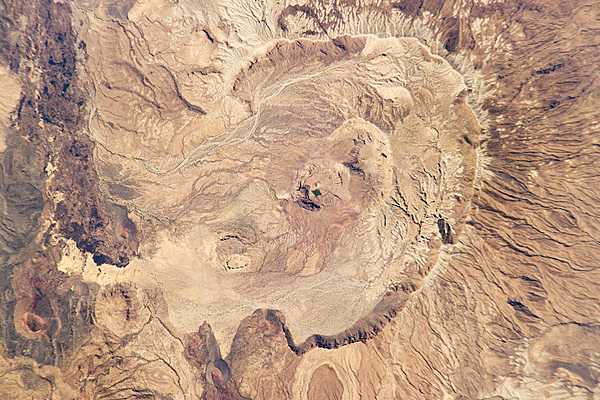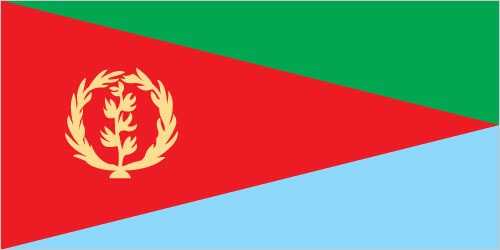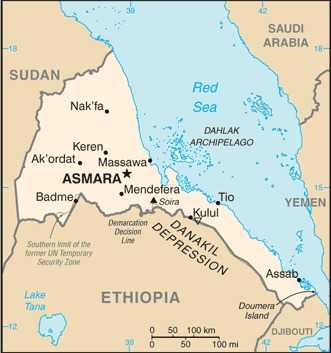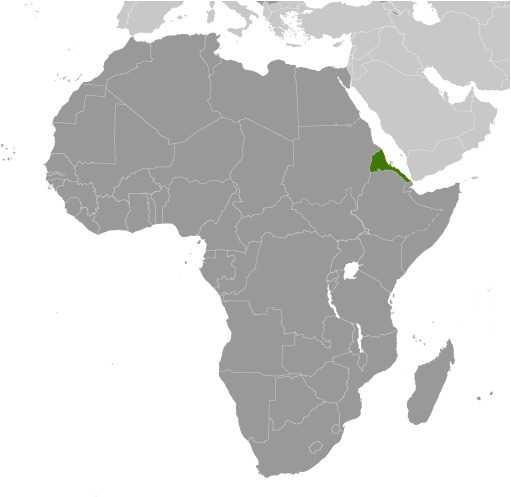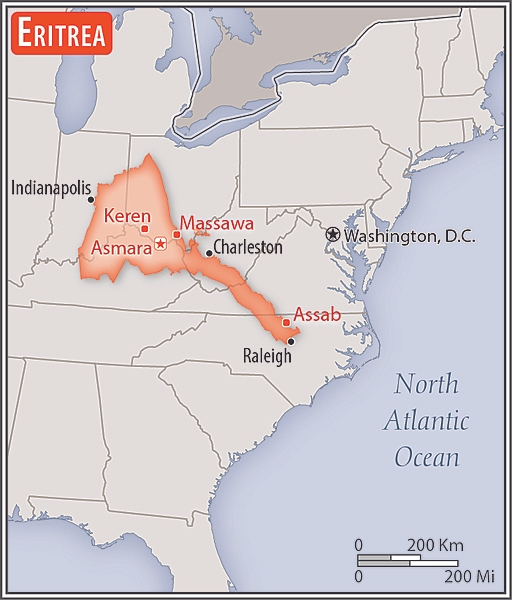Introduction
Background
Eritrea won independence from Italian colonial control in 1941, but the UN only established it as an autonomous region within the Ethiopian federation in 1952, after a decade of British administrative control. Ethiopia's full annexation of Eritrea as a province 10 years later sparked a violent 30-year conflict for independence that ended in 1991 with Eritrean fighters defeating government forces. Eritreans overwhelmingly approved independence in a 1993 referendum. ISAIAS Afwerki has been Eritrea's only president since independence; his rule, particularly since 2001, has been characterized by highly autocratic and repressive actions. His government has created a highly militarized society by instituting an unpopular program of mandatory conscription into national service -- divided between military and civilian service -- of indefinite length.
A two-and-a-half-year border war with Ethiopia that erupted in 1998 ended under UN auspices in 2000. Ethiopia rejected a subsequent 2007 Eritrea-Ethiopia Boundary Commission (EEBC) demarcation. More than a decade of a tense “no peace, no war” stalemate ended in 2018 when the newly elected Ethiopian prime minister accepted the EEBC’s 2007 ruling, and the two countries signed declarations of peace and friendship. Eritrean leaders then engaged in intensive diplomacy around the Horn of Africa, bolstering regional peace, security, and cooperation, as well as brokering rapprochements between governments and opposition groups. In 2018, the UN Security Council lifted an arms embargo that had been imposed on Eritrea since 2009, after the UN Somalia-Eritrea Monitoring Group reported they had not found evidence of Eritrean support in recent years for al-Shabaab. The country’s rapprochement with Ethiopia led to a resumption of economic ties, but the level of air transport, trade, and tourism have remained roughly the same since late 2020.
The Eritrean economy remains agriculture-dependent, and the country is still one of Africa’s poorest nations. Eritrea faced new international condemnation and US sanctions in mid-2021 for its participation in the war in Ethiopia’s Tigray Regional State, where Eritrean forces were found to have committed war crimes and crimes against humanity. As most Eritrean troops were departing northern Ethiopia in January 2023, ISAIAS began a series of diplomatic engagements aimed at bolstering Eritrea’s foreign partnerships and regional influence. Despite the country's improved relations with its neighbors, ISAIAS has not let up on repression, and conscription and militarization continue.
Visit the Definitions and Notes page to view a description of each topic.
Geography
Location
Eastern Africa, bordering the Red Sea, between Djibouti and Sudan
Geographic coordinates
15 00 N, 39 00 E
Map references
Africa
Land boundaries
total: 1,840 km
border countries (3): Djibouti 125 km; Ethiopia 1,033 km; Sudan 682 km
Coastline
2,234 km (mainland on Red Sea 1,151 km, islands in Red Sea 1,083 km)
Maritime claims
territorial sea: 12 nm
Climate
hot, dry desert strip along Red Sea coast; cooler and wetter in the central highlands (up to 61 cm of rainfall annually, heaviest June to September); semiarid in western hills and lowlands
Terrain
dominated by extension of Ethiopian north-south trending highlands, descending on the east to a coastal desert plain, on the northwest to hilly terrain and on the southwest to flat-to-rolling plains
Elevation
highest point: Soira 3,018 m
lowest point: near Kulul within the Danakil Depression -75 m
mean elevation: 853 m
Natural resources
gold, potash, zinc, copper, salt, possibly oil and natural gas, fish
Land use
agricultural land: 75.1% (2018 est.)
arable land: 6.8% (2018 est.)
permanent crops: 0% (2018 est.)
permanent pasture: 68.3% (2018 est.)
forest: 15.1% (2018 est.)
other: 9.8% (2018 est.)
Irrigated land
210 sq km (2012)
Population distribution
density is highest in the center of the country in and around the cities of Asmara (capital) and Keren; smaller settlements exist in the north and south as shown in this population distribution map
Natural hazards
frequent droughts, rare earthquakes and volcanoes; locust swarms
volcanism: Dubbi (1,625 m), which last erupted in 1861, was the country's only historically active volcano until Nabro (2,218 m) came to life on 12 June 2011
Geography - note
strategic geopolitical position along world's busiest shipping lanes; Eritrea retained the entire coastline of Ethiopia along the Red Sea upon de jure independence from Ethiopia on 24 May 1993
People and Society
Population
total: 6,343,956
male: 3,122,433
female: 3,221,523 (2024 est.)
comparison rankings: female 110; male 111; total 111
Nationality
noun: Eritrean(s)
adjective: Eritrean
Ethnic groups
Tigrinya 50%, Tigre 30%, Saho 4%, Afar 4%, Kunama 4%, Bilen 3%, Hedareb/Beja 2%, Nara 2%, Rashaida 1% (2021 est.)
note: data represent Eritrea's nine recognized ethnic groups
Languages
Tigrinya (official), Arabic (official), English (official), Tigre, Kunama, Afar, other Cushitic languages
Religions
Eritrean Orthodox, Roman Catholic, Evangelical Lutheran, Sunni Muslim
Demographic profile
Eritrea is a persistently poor country that has made progress in some socioeconomic categories but not in others. Education and human capital formation are national priorities for facilitating economic development and eradicating poverty. To this end, Eritrea has made great strides in improving adult literacy – doubling the literacy rate over the last 20 years – in large part because of its successful adult education programs. The overall literacy rate was estimated to be more than 75% in 2018; more work needs to be done to raise female literacy and school attendance among nomadic and rural communities. Subsistence farming fails to meet the needs of Eritrea’s growing population because of repeated droughts, dwindling arable land, overgrazing, soil erosion, and a shortage of farmers due to conscription and displacement. The government’s emphasis on spending on defense over agriculture and its lack of foreign exchange to import food also contribute to food insecurity.
Eritrea has been a leading refugee source country since at least the 1960s, when its 30-year war for independence from Ethiopia began. Since gaining independence in 1993, Eritreans have continued migrating to Sudan, Ethiopia, Yemen, Egypt, or Israel because of a lack of basic human rights or political freedom, educational and job opportunities, or to seek asylum because of militarization. Eritrea’s large diaspora has been a source of vital remittances, funding its war for independence and providing 30% of the country’s GDP annually since it became independent.
In the last few years, Eritreans have increasingly been trafficked and held hostage by Bedouins in the Sinai Desert, where they are victims of organ harvesting, rape, extortion, and torture. Some Eritrean trafficking victims are kidnapped after being smuggled to Sudan or Ethiopia, while others are kidnapped from within or around refugee camps or crossing Eritrea’s borders. Eritreans composed approximately 90% of the conservatively estimated 25,000-30,000 victims of Sinai trafficking from 2009-2013, according to a 2013 consultancy firm report.
Age structure
0-14 years: 35.7% (male 1,138,382/female 1,123,925)
15-64 years: 60.3% (male 1,882,547/female 1,944,266)
65 years and over: 4% (2024 est.) (male 101,504/female 153,332)
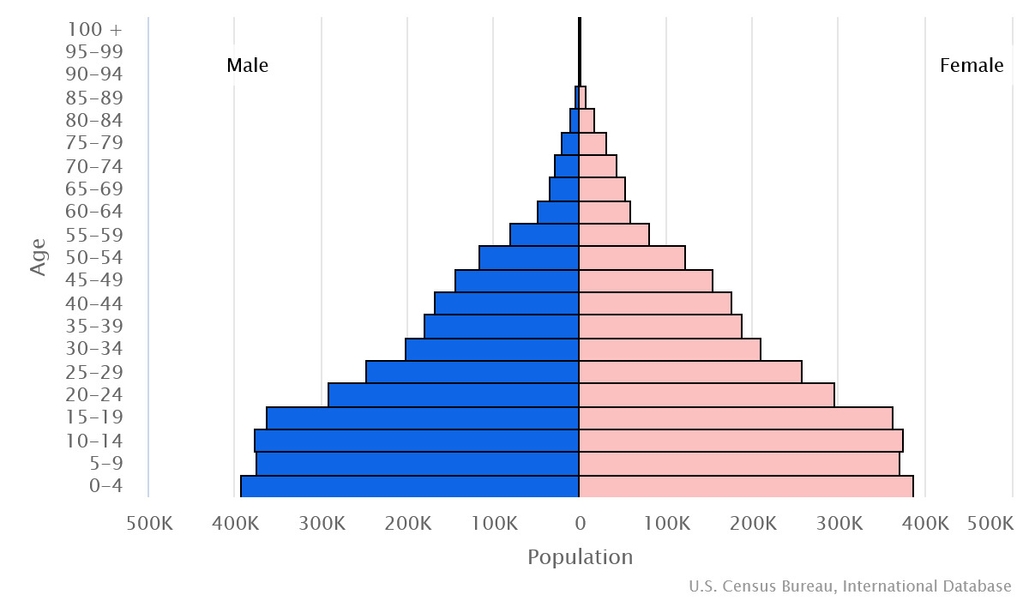
Dependency ratios
total dependency ratio: 77.9
youth dependency ratio: 70.8
elderly dependency ratio: 7.1
potential support ratio: 14 (2021 est.)
Median age
total: 21.3 years (2024 est.)
male: 20.8 years
female: 21.8 years
comparison ranking: total 192
Population distribution
density is highest in the center of the country in and around the cities of Asmara (capital) and Keren; smaller settlements exist in the north and south as shown in this population distribution map
Urbanization
urban population: 43.3% of total population (2023)
rate of urbanization: 3.67% annual rate of change (2020-25 est.)
Major urban areas - population
1.073 million ASMARA (capital) (2023)
Sex ratio
at birth: 1.03 male(s)/female
0-14 years: 1.01 male(s)/female
15-64 years: 0.97 male(s)/female
65 years and over: 0.66 male(s)/female
total population: 0.97 male(s)/female (2024 est.)
Mother's mean age at first birth
21.3 years (2010 est.)
note: data represents median age at first birth among women 25-29
Infant mortality rate
total: 39.8 deaths/1,000 live births (2024 est.)
male: 46.6 deaths/1,000 live births
female: 32.8 deaths/1,000 live births
comparison ranking: total 29
Life expectancy at birth
total population: 67.5 years (2024 est.)
male: 64.9 years
female: 70.2 years
comparison ranking: total population 197
Gross reproduction rate
1.69 (2024 est.)
Drinking water source
improved: urban: 73.2% of population
rural: 53.3% of population
total: 57.8% of population
unimproved: urban: 26.8% of population
rural: 46.7% of population
total: 42.2% of population (2015 est.)
Current health expenditure
4.1% of GDP (2020)
Physicians density
0.08 physicians/1,000 population (2020)
Hospital bed density
0.7 beds/1,000 population (2011)
Sanitation facility access
improved: urban: 44.5% of population
rural: 7.3% of population
total: 15.7% of population
unimproved: urban: 55.5% of population
rural: 92.7% of population
total: 84.3% of population (2017 est.)
Major infectious diseases
degree of risk: high (2023)
food or waterborne diseases: bacterial diarrhea, hepatitis A, and typhoid fever
vectorborne diseases: malaria and dengue fever
Alcohol consumption per capita
total: 0.93 liters of pure alcohol (2019 est.)
beer: 0.42 liters of pure alcohol (2019 est.)
wine: 0 liters of pure alcohol (2019 est.)
spirits: 0 liters of pure alcohol (2019 est.)
other alcohols: 0.51 liters of pure alcohol (2019 est.)
comparison ranking: total 153
Tobacco use
total: 7.5% (2020 est.)
male: 14.7% (2020 est.)
female: 0.2% (2020 est.)
comparison ranking: total 153
Currently married women (ages 15-49)
52.3% (2023 est.)
Literacy
definition: age 15 and over can read and write
total population: 76.6%
male: 84.4%
female: 68.9% (2018)
School life expectancy (primary to tertiary education)
total: 8 years
male: 8 years
female: 7 years (2015)
Environment
Environment - current issues
deforestation; desertification; soil erosion; overgrazing
Environment - international agreements
party to: Biodiversity, Climate Change, Climate Change-Kyoto Protocol, Comprehensive Nuclear Test Ban, Desertification, Endangered Species, Hazardous Wastes, Ozone Layer Protection, Whaling
signed, but not ratified: Climate Change-Paris Agreement
Climate
hot, dry desert strip along Red Sea coast; cooler and wetter in the central highlands (up to 61 cm of rainfall annually, heaviest June to September); semiarid in western hills and lowlands
Land use
agricultural land: 75.1% (2018 est.)
arable land: 6.8% (2018 est.)
permanent crops: 0% (2018 est.)
permanent pasture: 68.3% (2018 est.)
forest: 15.1% (2018 est.)
other: 9.8% (2018 est.)
Urbanization
urban population: 43.3% of total population (2023)
rate of urbanization: 3.67% annual rate of change (2020-25 est.)
Air pollutants
particulate matter emissions: 22.74 micrograms per cubic meter (2019 est.)
carbon dioxide emissions: 0.71 megatons (2016 est.)
methane emissions: 4.48 megatons (2020 est.)
Waste and recycling
municipal solid waste generated annually: 726,957 tons (2011 est.)
Total water withdrawal
municipal: 30 million cubic meters (2020 est.)
industrial: 1 million cubic meters (2017 est.)
agricultural: 550 million cubic meters (2020 est.)
Total renewable water resources
7.32 billion cubic meters (2020 est.)
Government
Country name
conventional long form: State of Eritrea
conventional short form: Eritrea
local long form: Hagere Ertra
local short form: Ertra
former: Eritrea Autonomous Region in Ethiopia
etymology: the country name derives from the ancient Greek appellation "Erythra Thalassa" meaning Red Sea, which is the major water body bordering the country
Government type
presidential republic
Capital
name: Asmara
geographic coordinates: 15 20 N, 38 56 E
time difference: UTC+3 (8 hours ahead of Washington, DC, during Standard Time)
etymology: the name means "they [women] made them unite," which according to Tigrinya oral tradition refers to the women of the four clans in the Asmara area who persuaded their menfolk to unite and defeat their common enemy; the name has also been translated as "live in peace"
Administrative divisions
6 regions (zobatat, singular - zoba); 'Anseba, Debub (South), Debubawi K'eyyih Bahri (Southern Red Sea), Gash-Barka, Ma'ikel (Central), Semienawi K'eyyih Bahri (Northern Red Sea)
Independence
24 May 1993 (from Ethiopia)
National holiday
Independence Day, 24 May (1991)
Constitution
history: ratified by the Constituent Assembly 23 May 1997 (never implemented)
amendments: proposed by the president of Eritrea or by assent of at least one half of the National Assembly membership; passage requires at least an initial three-quarters majority vote by the Assembly and, after one year, final passage by at least four-fifths majority vote by the Assembly
Legal system
mixed legal system of civil, customary, and Islamic religious law
International law organization participation
has not submitted an ICJ jurisdiction declaration; non-party state to the ICCt
Citizenship
citizenship by birth: no
citizenship by descent only: at least one parent must be a citizen of Eritrea
dual citizenship recognized: no
residency requirement for naturalization: 20 years
Suffrage
18 years of age; universal
Executive branch
chief of state: President ISAIAS Afwerki (since 24 May 1993); note - the president is both chief of state and head of government and is head of the State Council and National Assembly
head of government: President ISAIAS Afwerki (since 8 June 1993)
cabinet: State Council appointed by the president
elections/appointments: president indirectly elected by the National Assembly for a 5-year term (eligible for a second term), according to the constitution; the only election held was on 24 May 1993, following independence from Ethiopia (next postponed indefinitely)
election results: 1993: ISAIAS Afwerki elected president by the transitional National Assembly; percent of National Assembly vote - ISAIAS Afwerki (PFDJ) 95%, other 5%
Legislative branch
description: unicameral National Assembly (Hagerawi Baito) (150 seats; 75 members directly elected by simple majority vote and 75 members indirectly elected by the ruling party; members serve 5-year terms)
elections: in May 1997, following the adoption of the new constitution, 75 members of the PFDJ Central Committee (the old Central Committee of the EPLF), 60 members of the 527-member Constituent Assembly, which had been established in 1997 to discuss and ratify the new constitution, and 15 representatives of Eritreans living abroad were formed into a Transitional National Assembly to serve as the country's legislative body until countrywide elections to form a National Assembly were held; although only 75 of 150 members of the Transitional National Assembly were elected, the constitution stipulates that once past the transition stage, all members of the National Assembly will be elected by secret ballot of all eligible voters; National Assembly elections scheduled for December 2001 were postponed indefinitely due to the war with Ethiopia, and as of 2023, no sitting legislative body exists
election results: NA
Judicial branch
highest court(s): High Court (consists of 20 judges and organized into civil, commercial, criminal, labor, administrative, and customary sections)
judge selection and term of office: High Court judges appointed by the president
subordinate courts: regional/zonal courts; community courts; special courts; sharia courts (for issues dealing with Muslim marriage, inheritance, and family); military courts
Political parties and leaders
People's Front for Democracy and Justice or PFDJ [ISAIAS Afwerki] (the only party recognized by the government)
International organization participation
ACP, AfDB, AU, COMESA, FAO, G-77, IAEA, IBRD, ICAO, ICC (NGOs), IDA, IFAD, IFC, IFRCS (observer), IGAD, ILO, IMF, IMO, Interpol, IOC, ISO (correspondent), ITU, ITUC (NGOs), LAS (observer), MIGA, NAM, OPCW, PCA, UN, UNCTAD, UNESCO, UNHRC, UNIDO, UNWTO, UPU, WCO, WFTU (NGOs), WHO, WIPO, WMO
Diplomatic representation in the US
chief of mission: Ambassador (vacant); Chargé d'Affaires Berhane Gebrehiwet SOLOMON (since 15 March 2011)
chancery: 1708 New Hampshire Avenue NW, Washington, DC 20009
telephone: [1] (202) 319-1991
FAX: [1] (202) 319-1304
email address and website:
embassyeritrea@embassyeritrea.org
https://us.embassyeritrea.org/
Diplomatic representation from the US
chief of mission: Ambassador (vacant); Chargé d'Affaires Leslie FRERIKSEN (since 18 July 2022)
embassy: 179 Alaa Street, Asmara
mailing address: 7170 Asmara Place, Washington DC 20521-7170
telephone: [291] (1) 12-00-04
FAX: [291] (1) 12-75-84
email address and website:
consularasmara@state.gov
https://er.usembassy.gov/
Flag description
red isosceles triangle (based on the hoist side) dividing the flag into two right triangles; the upper triangle is green, the lower one is blue; a gold wreath encircling a gold olive branch is centered on the hoist side of the red triangle; green stands for the country's agriculture economy, red signifies the blood shed in the fight for freedom, and blue symbolizes the bounty of the sea; the wreath-olive branch symbol is similar to that on the first flag of Eritrea from 1952; the shape of the red triangle broadly mimics the shape of the country
note: one of several flags where a prominent component of the design reflects the shape of the country; other such flags are those of Bosnia and Herzegovina, Brazil, and Vanuatu
National symbol(s)
camel; national colors: green, red, blue
National anthem
name: "Ertra, Ertra, Ertra" (Eritrea, Eritrea, Eritrea)
lyrics/music: SOLOMON Tsehaye Beraki/Isaac Abraham MEHAREZGI and ARON Tekle Tesfatsion
note: adopted 1993; upon independence from Ethiopia
National heritage
total World Heritage Sites: 1 (cultural)
selected World Heritage Site locales: Asmara: A Modernist African City
Economy
Economic overview
largely agrarian economy with a significant mining sector; substantial fiscal surplus due to tight controls; high and vulnerable debts; increased Ethiopian trade and shared port usage decreasing prices; financial and economic data integrity challenges
Real GDP (purchasing power parity)
$9.702 billion (2017 est.)
$8.953 billion (2016 est.)
$8.791 billion (2015 est.)
note: data are in 2017 dollars
comparison ranking: 165
Real GDP per capita
$1,600 (2017 est.)
$1,500 (2016 est.)
$1,500 (2015 est.)
note: data are in 2017 dollars
comparison ranking: 212
GDP (official exchange rate)
$5.813 billion (2017 est.)
GDP - composition, by sector of origin
agriculture: 11.7% (2017 est.)
industry: 29.6% (2017 est.)
services: 58.7% (2017 est.)
comparison rankings: services 133; industry 79; agriculture 83
GDP - composition, by end use
household consumption: 80.9% (2017 est.)
government consumption: 24.3% (2017 est.)
investment in fixed capital: 6.4% (2017 est.)
investment in inventories: 0.1% (2017 est.)
exports of goods and services: 10.9% (2017 est.)
imports of goods and services: -22.5% (2017 est.)
Agricultural products
sorghum, milk, barley, vegetables, root vegetables, cereals, pulses, millet, wheat, beef (2022)
note: top ten agricultural products based on tonnage
Industries
food processing, beverages, clothing and textiles, light manufacturing, salt, cement
Industrial production growth rate
4.3% (2014 est.)
note: annual % change in industrial value added based on constant local currency
comparison ranking: 88
Labor force
1.749 million (2022 est.)
note: number of people ages 15 or older who are employed or seeking work
comparison ranking: 131
Unemployment rate
5.97% (2022 est.)
6.51% (2021 est.)
6.45% (2020 est.)
note: % of labor force seeking employment
comparison ranking: 122
Youth unemployment rate (ages 15-24)
total: 14.6% (2021 est.)
male: 13.1%
female: 16.4%
comparison ranking: total 121
Population below poverty line
50% (2004 est.)
Budget
revenues: $633 million (2018 est.)
expenditures: $549 million (2018 est.)
Fiscal year
calendar year
Exports - partners
China 52%, UAE 33%, South Korea 9%, Japan 2%, Madagascar 2% (2022)
note: top five export partners based on percentage share of exports
Exports - commodities
zinc ore, gold, copper ore, wheat, garments (2022)
note: top five export commodities based on value in dollars
Imports - partners
China 34%, UAE 26%, Turkey 12%, US 7%, India 4% (2022)
note: top five import partners based on percentage share of imports
Imports - commodities
ships, sorghum, wheat, construction vehicles, other foods (2022)
note: top five import commodities based on value in dollars
Reserves of foreign exchange and gold
$191.694 million (2019 est.)
$163.034 million (2018 est.)
$143.412 million (2017 est.)
note: holdings of gold (year-end prices)/foreign exchange/special drawing rights in current dollars
comparison ranking: 181
Debt - external
$792.7 million (31 December 2017 est.)
$875.6 million (31 December 2016 est.)
comparison ranking: 170
Exchange rates
nakfa (ERN) per US dollar -
Exchange rates:
15.075 (2022 est.)
15.075 (2021 est.)
15.075 (2020 est.)
15.075 (2019 est.)
15.075 (2018 est.)
Energy
Electricity access
population without electricity: 3 million (2020)
electrification - total population: 52.5% (2021)
electrification - urban areas: 75.6% (2019)
electrification - rural areas: 35.7% (2021)
Electricity
installed generating capacity: 228,000 kW (2020 est.)
consumption: 394.46 million kWh (2019 est.)
exports: 0 kWh (2019 est.)
imports: 0 kWh (2019 est.)
transmission/distribution losses: 61 million kWh (2019 est.)
comparison rankings: installed generating capacity 166; transmission/distribution losses 45; imports 178; exports 170; consumption 176
Electricity generation sources
fossil fuels: 93.8% of total installed capacity (2020 est.)
nuclear: 0% of total installed capacity (2020 est.)
solar: 5.7% of total installed capacity (2020 est.)
wind: 0.5% of total installed capacity (2020 est.)
hydroelectricity: 0% of total installed capacity (2020 est.)
tide and wave: 0% of total installed capacity (2020 est.)
geothermal: 0% of total installed capacity (2020 est.)
biomass and waste: 0% of total installed capacity (2020 est.)
Coal
production: 0 metric tons (2020 est.)
consumption: 0 metric tons (2020 est.)
exports: 0 metric tons (2020 est.)
imports: 0 metric tons (2020 est.)
proven reserves: 0 metric tons (2019 est.)
Petroleum
total petroleum production: 0 bbl/day (2021 est.)
refined petroleum consumption: 5,200 bbl/day (2019 est.)
crude oil and lease condensate exports: 0 bbl/day (2018 est.)
crude oil and lease condensate imports: 0 bbl/day (2018 est.)
crude oil estimated reserves: 0 barrels (2021 est.)
Natural gas
production: 0 cubic meters (2021 est.)
consumption: 0 cubic meters (2021 est.)
exports: 0 cubic meters (2021 est.)
imports: 0 cubic meters (2021 est.)
proven reserves: 0 cubic meters (2021 est.)
Carbon dioxide emissions
798,000 metric tonnes of CO2 (2019 est.)
from coal and metallurgical coke: 0 metric tonnes of CO2 (2019 est.)
from petroleum and other liquids: 798,000 metric tonnes of CO2 (2019 est.)
from consumed natural gas: 0 metric tonnes of CO2 (2019 est.)
comparison ranking: total emissions 179
Communications
Telephones - fixed lines
total subscriptions: 66,000 (2021 est.)
subscriptions per 100 inhabitants: 2 (2021 est.)
comparison ranking: total subscriptions 147
Telephones - mobile cellular
total subscriptions: 1.8 million (2021 est.)
subscriptions per 100 inhabitants: 50 (2021 est.)
comparison ranking: total subscriptions 156
Telecommunication systems
general assessment: Eritrea’s telecom sector operates under a state-owned monopoly for fixed and mobile services; as a result of such restrictions on competition, the country has the least developed telecommunications market in Africa; mobile penetration stands at only about 20%, while fixed-line internet use barely registers; this is exacerbated by the very low use of computers, with only about 4% of households having a computer, and most of these being in the capital, Asmara; the 3G network continues to rollout which provides basic internet access to a limited number of Eritreans who can afford the expensive services; investment in telecom infrastructure is still required to improve the quality of services; the government has embarked on a work program to do exactly that, specifically aimed at extending services to remote areas, improving the quality of services, and ensuring that more telecoms infrastructure is supported by solar power to compensate for the poor state of the electricity network (2022)
domestic: fixed-line subscribership is less than 2 per 100 persons and mobile-cellular is just over 50 per 100 (2021)
international: country code - 291 (2019)
Broadcast media
government controls broadcast media with private ownership prohibited; 1 state-owned TV station; 2 state-owned radio networks; purchases of satellite dishes and subscriptions to international broadcast media are permitted (2023)
Internet users
total: 792,000 (2021 est.)
percent of population: 22% (2021 est.)
comparison ranking: total 156
Broadband - fixed subscriptions
total: 5,000 (2020 est.)
subscriptions per 100 inhabitants: 0.1 (2020 est.)
comparison ranking: total 189
Transportation
National air transport system
number of registered air carriers: 1 (2020)
inventory of registered aircraft operated by air carriers: 1
annual passenger traffic on registered air carriers: 102,729 (2018)
Roadways
total: 16,000 km (2018)
paved: 1,600 km (2000)
unpaved: 14,400 km (2000)
comparison ranking: total 120
Merchant marine
total: 9 (2023)
by type: general cargo 4, oil tanker 1, other 4
comparison ranking: total 161
Ports and terminals
major seaport(s): Assab, Massawa
Military and Security
Military and security forces
Eritrean Defense Forces (EDF): Eritrean Ground Forces, Eritrean Navy, Eritrean Air Force (includes Air Defense Force); People's Militia (aka People's Army or Hizbawi Serawit) (2023)
note: police are responsible for maintaining internal security, but the government sometimes used the armed forces, reserves, demobilized soldiers, or civilian militia to meet domestic as well as external security requirements; the armed forces have authority to arrest and detain civilians
Military expenditures
10% of GDP (2019 est.)
10.2% of GDP (2018 est.)
10.3% of GDP (2017 est.)
10.4% of GDP (2016 est.)
10.6% of GDP (2015 est.)
comparison ranking: 1
Military and security service personnel strengths
limited available information; estimated 150,000-200,000 personnel (2023)
Military equipment inventories and acquisitions
the EDF inventory is comprised primarily of older Russian and Soviet-era systems; Eritrea was under a UN arms embargo from 2009 to 2018; from the 1990s to 2008, Russia was the leading supplier of arms to Eritrea, and in recent years, Eritrea has expressed interest in purchasing additional Russian equipment; in 2022, it reportedly received some UAVs from Russia (2023)
Military service age and obligation
Eritrea mandates military service for all citizens between the ages of 18 and 40; 18-month conscript service obligation, which includes 4-6 months of military training and 12 months of military or other national service (military service is most common); in practice, military and national service is often extended indefinitely; citizens up to the age of 55 eligible for recall during mobilization (2023)
note: as of 2020, women were estimated to make up as much as 30% of the Eritrean military
Military - note
the military’s primary responsibilities are external defense, border security, and providing the regime a vehicle for national cohesion; the Army is the dominant service; it is a large, conscript-based force and estimated to have more than 20 infantry divisions, including some that are mechanized, as well as a division of commandos/special forces; the Air Force has a small number of Soviet-era combat aircraft and helicopters, while the Navy maintains a limited number of coastal patrol vessels
since the country's independence in 1991, the Eritrean military has participated in numerous conflicts, including the Hanish Island Crisis with Yemen (1995), the First Congo War (1996-1997), the Second Sudanese Civil War (1996-1998), the Eritrea-Ethiopia War (1998-2000), the Djiboutian-Eritrean border conflict (2008), and the Tigray conflict in Ethiopia (2020-2022); during the Tigray conflict, the Eritrean Defense Forces were accused of widespread human rights abuses including executions, rape, and torture of civilians within Ethiopia (2023)
Transnational Issues
Trafficking in persons
tier rating:
Tier 3 — Eritrea does not fully meet the minimum standards for the elimination of trafficking and is not making significant efforts to do so, therefore Eritrea remained on Tier 3; the government continued to have a policy or pattern of human trafficking; the government exploited its citizens in forced labor in its compulsory national service and citizen militia by forcing them to serve indefinitely or for arbitrary periods; officials directed policies that perpetuated mobilization of children for forced labor in public works projects, usually within the agricultural sector, during the student summer work program known as Maetot; the government did not demonstrate any efforts to address human trafficking (2023)
trafficking profile: human traffickers exploit domestic victims in Eritrea and abroad, and may exploit foreign victims in Eritrea; National Service is mandatory at age 18 and may take a variety of forms, including military service and physical labor but also the full range of government jobs, as well as teaching; the 18-month limit on compulsory national service was suspended since the 1998-2000 Eritrean-Ethiopian border conflict, blocking the demobilization of most individuals who are forced to serve indefinitely under threats of detention, torture, or familial reprisal; Eritreans who flee the country, usually with the aim of reaching Europe, seek the help of paid smugglers to evade Eritrea’s strict exit controls and are vulnerable to trafficking; Eritreans are subject to forced labor and sex trafficking mainly in Ethiopia, Libya, and Sudan; Eritrean military and security officials reportedly subject young women and girls to domestic servitude and sex trafficking, as well as committing human rights abuses and gender-based violence against women and girls in Tigray; Chinese nationals employed at worksites affiliated with China’s Belt and Road Initiative are vulnerable to forced labor, including in construction and mining (2023)
